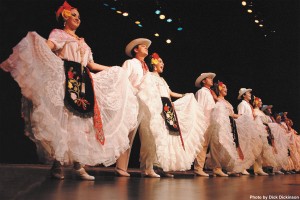HBPA: Ballet Foklórico “Quetzalli” de Veracruz
Ballet Foklórico, a performance of authentic Mexican dance and music took the audience through multiple regions and time periods in “a visual fiesta of culture and folklore,” on Saturday, Feb. 23 as a part of the Hesston – Bethel Performing Arts Series. Sophomores Alyssa Rychener and Mallory Eicher review the performance, in Spanish and English:

by Alyssa Rychener – Guest Writer
Ballet Folklórico es un grupo de bailadores que tiene el propósito de presentarle la cultura de México a todo el mundo por sus danzas, su ropa, y su música. El grupo interpreta muchos bailes de regiones diferentes y unas variedades de épocas. Unas danzas son de los grupos nativos, como los aztecas, y algunas tienen mucha influencia española. Para compartir la cultura con el público, Ballet Folklórico tiene una banda que toca instrumentos auténticos y que canta en armonía para proporcionar música tradicional para las danzas. Los bailadores llevan ropa tradicional con muchos colores. Por medio de todas estas cosas, Ballet Folklórico puede darles un sabor de la historia y cultura de México y las diferencias culturales por el país.
Todas las danzas tenían influencias diferentes, entonces todos los estilos de música, ropa, y baile eran diferentes también. La música era la más diferente. La música de la primera danza, “Danza de Concheros,” usó solo un tambor. Es una danza de los nativos con un poco de influencia de los conquistadores. En las danzas de Fandango Jarocho la música tenía más influencia española. La música era muy animada y usaba mucho el arpa, un instrumento específico a la región de esta danza.
Las desemejantes entre las danzas seguían las de la música. La mayoría de las danzas eran animadas y rápidas pero todavía eran diferentes. La danza de México antiguo tenía más ritmo fuerte especialmente con los pies. Las otras eran un poco el mismo en esta manera pero no era la única parte de la danza. En las danzas de Veracruz, la danza era como una procesión y una manera para darle respeto a la Virgen. Esta danza es parte de una tradición religiosa. Otra danza que fue diferente fueron las de Fandango Jarocho. Las danzas de esta región, que celebran una fiesta, son animadas y a veces los bailadores bailan en pares.
La ropa que se llevaban indicó el tiempo y la influencia también. En la danza de las indígenas, la ropa era mínima pero muy colorada. Los bailadores llevaban plumas en la cabeza y tobilleras indígnas alrededor de los tobillos. Luego, para la danza de Fandango Jarocho las mujeres llevaban vestidos blancos con un poco de colores brillantes. Esta ropa tenía la más influencia española. Otra danza del Baja California Norte tenía influencia del norte. La ropa era típica de los vaqueros del norte, y usaba telas de vaquero y cuero. Toda la ropa para el programa era colorada como el quetzal, que es muy colorado. Por eso el grupo es conocido por el nombre “Quetzalli.”
Todas las partes del programa nos presentaron música, danzas, y ropa como un artefacto de la cultura y la historia de México. Ballet Folklórico pudo compartir el gozo y el sentido de las tradiciones casi sin palabras y solo con música y baile.
by Mallory Eicher – Guest Writer
The accompanying music provided by Tlen-Huicani featured traditional instruments, adding to the cultural preservation of the dances. Each dance contained elements of the region and time period from which it originated, and these elements were often present in both the dress as well as the actions of the dancers.
The most striking differences between the dances were the outfits. The ancient dances were easy to identify because of their use of more “natural” and minimal clothing involving feathers and little else. The European influences (in the form of Christianity) were heavily prevalent during the Veracruz, Huasteca dances that paid homage to the Virgin of Guadalupe. Regional styles, too, were present in the traditional blankets worn during the Guerrero dances overtop the outfits of the male dancers and dancers’ tying of the ribbon bow using only their feet during the Fandango dances.
During the dances themselves, different actions provided a glimpse into the lives of the people from whom the dances originated. The ancient dances were mostly danced in large groups, adding a rougher, more primitive feel to them. Dances that were developed more recently featured couples stepping together harmoniously. The Veracruz, Huasteca dances were much more somber, as well, befitting the more serious nature of the dance as they paid tribute to the Virgin of Guadalupe.
The word Quetzalli itself is a word from the indigenous Nahuatl language meaning “something precious.” Ballet Foklórico is a group dedicated to preserving culturally significant dances, and so their name, Quetzalli, is appropriate when considering that the dances are precious to the history of the various regions.
After each musical interlude when the dancers would again take the stage, it was like the audience was transported to another time and region than they had previously found themselves in. In this way, Ballet Foklórico was successful in conveying the idea of a cultural significance and a look into history with its dances, but I wish the dancers would have spoken or given some history behind the dances. There was information about the dances in the program, but it was hard to read with the darkness of the auditorium.
Overall, however, Ballet Foklórico provided me a unique glimpse into the traditions and life of an old and culturally rich people from a background different than my own.

